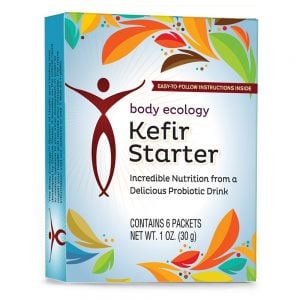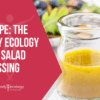
Miso soup: A delicious bowl of health and anti-aging potential?
There’s a great debate about soy in the health food world today. Once thought to be the cure-all for many ills and the lifesaver for vegetarian and gluten-free diets, more and more studies are showing what we at Body Ecology have known for some time: Soy is not the health food you may think it is — unless it’s fermented and non-GMO.
For more tasty fermented foods, try your hand at kefir. Body Ecology’s highly-rated Kefir Starter makes it easy to ferment at home in just a few steps.
Unfermented soy may be linked to digestive distress, immune system breakdown, endometriosis, reproductive problems for men and women, allergies, ADD, higher risk of heart disease and possible cancer, malnutrition, and loss of libido.1-7
But a 2020 study found that consuming fermented soy foods, like miso and natto, may lower risk of mortality.8
Say goodbye to soy? Fermentation to the rescue
While sales of soy have slowed as we’ve learned about the potential dangers, there are still people consuming it.
According to Kaayla T. Daniel, Ph.D., who wrote The Whole Soy Story, the most at-risk populations are: infants who are taking soy baby formula, vegetarians (especially vegans) eating a high-soy diet, and mid-life women eating a lot of soyfoods, thinking it will help with the symptoms of menopause.2
So, how can you get the benefits of soy, without the negative effects?
Fermented foods and drinks are a cornerstone of the Body Ecology program because they help build your inner ecosystem. When your inner ecosystem is healthy, it’s full of friendly microbes (beneficial bacteria in your intestines) that help digest and assimilate nutrients and boost your immunity.
In fact, healthy microbes actually go to work for you, helping to create the vitamins and minerals your body needs to stay strong and energized. When you follow the Body Ecology program, you begin to build energy so that your body can help correct digestion, conquer infections, and cleanse.
Once your systemic fungal infection is under control, we recommend adding fermented soy foods, like miso soup, natto, and tempeh. Soyfoods are high in copper, and we’ve found that high-copper foods often aren’t tolerated when a person has candidiasis.
The many benefits of miso (or, what makes miso so amazing)
Miso has been eaten in Japan and China for many centuries and has been attracting the attention of many because of its health and anti-aging benefits. It’s also quite delicious. When you aren’t feeling well, a bowl of miso soup can be especially soothing.
While it was once thought that soy was the reason for the low rates of heart disease and breast and prostate cancers in Asia, more evidence is now showing us that it’s the consumption of traditional fermented soy products (usually eaten every day) that are providing the real payoffs.
Traced from ancient China — where it was known as hisio, a seasoning prized by aristocrats — miso was perfected in Japan from the 7th century to today.
Miso is an art form in Japan. It’s made of soybeans and koji, a culture starter containing beneficial molds, yeast, and lactic acid bacteria. As long as you choose unpasteurized miso, you’ll be getting the benefits of live, friendly microbes for the health of your inner ecosystem.
There are many types of miso, some made with just soybeans and soy koji (called Hatcho miso, a favorite in Japan), and others made with barley and rice. No matter which type you choose, this fermented superfood has many health effects.
Numerous studies have been done on miso, some on humans and some on animals. These studies show the following benefits of miso:
- Antiviral — Miso is very alkalizing and strengthening to the immune system, helping to combat viral infection.9
- Contains probiotics that may relieve digestive distress and even symptoms of IBD.10
- Helps maintain nutritional balance — Full of nutrients, beneficial bacteria, and enzymes, miso provides: protein, vitamin B2, vitamin B12, vitamin E, vitamin K, tryptophan, choline, dietary fiber, linoleic acid, and lecithin.
- Helps protect against radiation.11
- Helps reduce risk of cancer, including breast, prostate, lung, and colon cancers.11
- Helps support beautiful skin — Miso contains linoleic acid, an essential fatty acid that helps your skin stay soft and free of pigments.12
- May prevent aging — High in antioxidants, miso protects from free radicals that can cause signs of aging.13
- May reduce menopausal complaints — The isoflavones in miso have been shown to ease hot flashes.14
- Supports balanced blood pressure, seen when eating two or more bowls a day.11
Soy protein is hard to digest and takes a long, slow process of fermentation to break it down. Bacteria that can digest soy are much hardier than the more fragile bacteria used to ferment vegetables, young coconut water, and milk products. (So, while you may love our line of Starters, they won’t help you make homemade miso. But they will help you make a variety of other probiotic-rich fermented foods and drinks.)
With miso, length of fermentation matters. Hiro Watanabe, Ph.D., an expert in developmental biology and cancer prevention in Japan, conducted several animal and human studies using freeze-dried rice miso to better understand how miso protects against cancer, radiation, and other diseases.11
Dr. Watanabe’s studies showed that when it comes to helping heal illnesses like breast and prostate cancers, the ideal length of fermentation was between 180 days (six months) and two years.
Dr. Watanabe found that miso fermented for 180 days is typically a rich color and has plenty of healthy microbes. After two years of fermentation, the amount of friendly bacteria begins to disappear. And while the miso would still be a fermented food and isn’t “spoiled,” there is a risk that other pathogens can grow.
Really healthy recipes can also taste really delicious. Click here to learn more.
Should you start sipping miso soup for your health?
According to Dr. Watanabe’s studies, the sodium in miso did not show adverse effects for people with salt sensitivity and hypertension.11
Here are the amounts of miso soup he recommended for different health conditions:
- Cancer prevention – 3 or more cups per day.
- High blood pressure – 2 cups per day.
- Menopause – 1 to 3 cups per day.
Special note: Here at Body Ecology, we recommend eating less miso in the summer months because your body needs much less salt in hot weather. Donna often suggests adding it to salads, cultured veggies, or salad dressings during the summertime. In cold weather, miso is a great food to eat every day.
For health maintenance, follow your intuition when it comes to how much miso soup you enjoy. This delicious, healing food can help you nourish yourself to optimal health.
How to make your own miso soup: It only takes 4 ingredients
When you’re ready to introduce the benefits of miso into your diet, you have more options than soup:
- For example, you can blend this certified organic miso
(made with healthy sea salt) with your cultured vegetables. (Miso Master is another recommended brand; check with your local health food store.)
- Or, add it to salad dressings for a flavorful dose of protein, minerals, and anti-aging power.
You can also sip your miso in a warming cup of soup as the Japanese have been doing to stay healthy for centuries.
If you’re really in a hurry, simply dissolve a heaping spoonful of your favorite miso paste into a cup of hot water that you’ve poured into a coffee mug. Spoon some cultured veggies into another bowl, add some roasted pumpkin seed oil and some sea salt to these, and enjoy a perfectly balanced meal. This is fast food at its finest.
To make a more traditional miso soup, follow this easy recipe:
Ingredients:
- 5-inch strip wakame (sea vegetable)
- 1 large onion (about 1 cup sliced)
- 4 cups filtered water
- 2 tablespoons miso (ideally, fermented for six months to two years)
- Garnish – chopped parsley, green onions, ginger, or watercress
Instructions:
1. Soak the wakame in water for 10 minutes and slice into 1.5-inch pieces.
2. Thinly slice onions.
3. Put water, onions, and wakame in a saucepan and bring to a boil. Reduce the heat to simmer for 10 to 20 minutes, until tender.
4. Remove 1.5 cups of broth from the saucepan, place in a bowl.
5. Allow water in the bowl to cool a bit and add the miso, mixing it into the water. (The water should not be boiling because it can kill the live, beneficial microbes and enzymes in miso. In general, the microbes in koji, the starter used to make miso, die at 105°F.)
6. Turn off heat, allow the water to cool a bit.
7. Add the miso broth to the soup in the saucepan and add chopped parsley, green onions, ginger, or watercress for garnish.
Recipe note: The above recipe is a vegetarian version. You can also add bonito flakes (dried fish). Check out these bonito flakes on Amazon or check with your local Asian market. Simmer 1 tablespoon of bonito flakes in the water for 10 minutes and strain. Then continue as noted above. When made with the dried fish as a quick stock, your miso soup should be even more strengthening.
REFERENCES:
- 1. Pan L, Farouk MH, Qin G, Zhao Y, Bao N. The Influences of Soybean Agglutinin and Functional Oligosaccharides on the Intestinal Tract of Monogastric Animals. Int J Mol Sci. 2018;19(2):554. Published 2018 Feb 12. doi:10.3390/ijms19020554.
- 2. Daniel, Kaayla T. The Whole Soy Story: the Dark Side of Americas Favorite Health Food. New Trends Publishing, 2005.
- 3. Mvondo MA, Ekenfack JD, Minko Essono S, Saah Namekong H, Awounfack CF, Laschke MW, Njamen D. Soy Intake Since the Prepubertal Age May Contribute to the Pathogenesis of Endometriosis in Adulthood. J Med Food. 2019 Jun;22(6):631-638. doi: 10.1089/jmf.2018.0160. Epub 2019 Mar 13. PMID: 30864871.
- 4. Siepmann T, Roofeh J, Kiefer FW, Edelson DG. Hypogonadism and erectile dysfunction associated with soy product consumption. Nutrition. 2011 Jul-Aug;27(7-8):859-62. doi: 10.1016/j.nut.2010.10.018. Epub 2011 Feb 25. PMID: 21353476.
- 5. “Statement from Susan Mayne, Ph.D., on proposal to revoke health claim that soy protein reduces risk of heart disease.” FDA, 2017.
- 6. Enderlin CA, Coleman EA, Stewart CB, Hakkak R. Dietary soy intake and breast cancer risk. Oncol Nurs Forum. 2009 Sep;36(5):531-9. doi: 10.1188/09.ONF.531-539. PMID: 19726393.
- 7. Chavarro JE, Toth TL, Sadio SM, Hauser R. Soy food and isoflavone intake in relation to semen quality parameters among men from an infertility clinic. Hum Reprod. 2008 Nov;23(11):2584-90. doi: 10.1093/humrep/den243. Epub 2008 Jul 23. PMID: 18650557; PMCID: PMC2721724.
- 8. Ryoko Katagiri, Norie Sawada, Atsushi Goto, Taiki Yamaji, Motoki Iwasaki, Mitsuhiko Noda, Hiroyasu Iso, Shoichiro Tsugane. Association of soy and fermented soy product intake with total and cause specific mortality: prospective cohort study. BMJ, 2020; m34 DOI: 10.1136/bmj.m34.
- 9. Kumazawa T, Nishimura A, Asai N, Adachi T. Isolation of immune-regulatory Tetragenococcus halophilus from miso. PLoS One. 2018 Dec 26;13(12):e0208821. doi: 10.1371/journal.pone.0208821. PMID: 30586377; PMCID: PMC6306251.
- 10. Okada, Yoshikiyo. Tu2021 Anti-Inflammatory Effect of Novel Probiotic Yeasts Isolated From Japanese “Miso” on DSS-Induced Colitis, Gastroenterology, Volume 150, Issue 4, Supplement 1, April 2016, Page S1008.
- 11. Watanabe H. Beneficial biological effects of miso with reference to radiation injury, cancer and hypertension. J Toxicol Pathol. 2013;26(2):91-103. doi:10.1293/tox.26.91.
- 12. McCusker MM, Grant-Kels JM. Healing fats of the skin: the structural and immunologic roles of the omega-6 and omega-3 fatty acids. Clin Dermatol. 2010 Jul-Aug;28(4):440-51. doi: 10.1016/j.clindermatol.2010.03.020. PMID: 20620762.
- 13. Sheih IC, Fang TJ, Wu TK, Chen RY. Effects of fermentation on antioxidant properties and phytochemical composition of soy germ. J Sci Food Agric. 2014 Dec;94(15):3163-70. doi: 10.1002/jsfa.6666. Epub 2014 Apr 14. PMID: 24652711.
- 14. Nagata C, Shimizu H, Takami R, Hayashi M, Takeda N, Yasuda K. Hot flushes and other menopausal symptoms in relation to soy product intake in Japanese women. Climacteric. 1999 Mar;2(1):6-12. doi: 10.3109/13697139909025557. PMID: 11910681.









